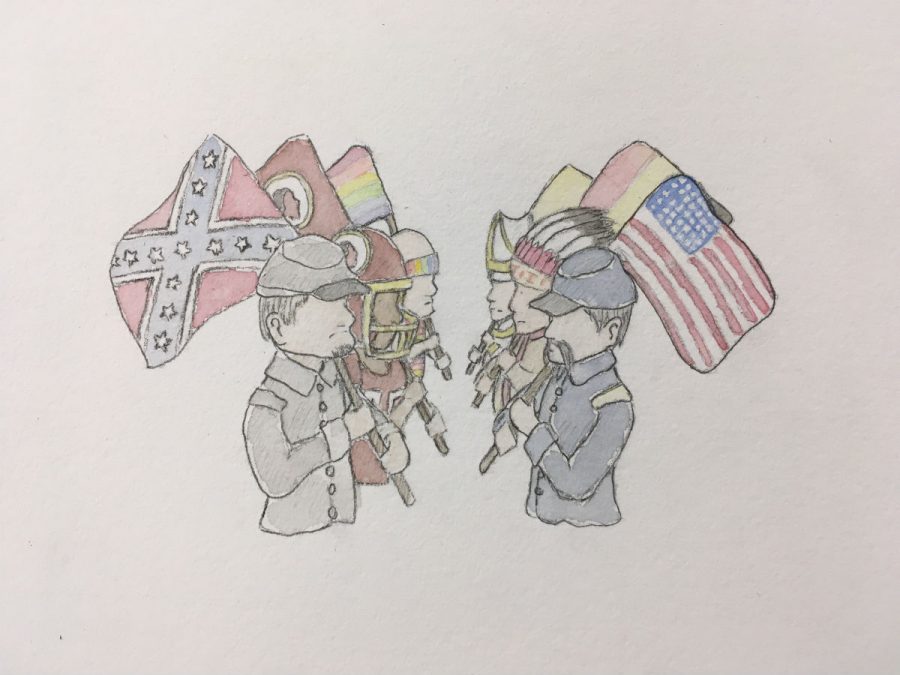More than a symbol
The Lantern analyzes the meaning behind symbols that we sometimes forget to think about.
Flags are some of the many symbols that shape our lives and our beliefs
In October Cannon Falls underwent a rather exciting homecoming week. Teachers became slightly more relaxed and a good chunk of students participated in dress up days. Thursday (country day), sitting in one of my classes, I was ready to hunker in for an intense hour of my group attempting to complete our project. Across from me our teacher was having a very intense conversation with a fellow high schooler. At the time the room was fairly quiet, so it was very difficult for me not to overhear. “Do you realize what that represents to certain people?” my teacher asked. “I know what it means,” the student replied. Together the student and teacher chatted for awhile, eventually ending with the teacher angrily sitting back down at their desk. Looking closely at the student who “knew what it means,” I noticed what my teacher was talking about. Around this individual’s waste was a belt, with a centerpiece of blue bars and stars: the Confederate flag. From southern pride to oppression, this flag represents two very different things. Symbols, especially flags like the Confederate, mean way more than many understand. Now, Americans are very privileged with their abundant freedoms, yet understanding what certain images portray is important. Whether it be the a pride flag, a football helmet, or a Confederate flag, items may have a deeper meaning than most can comprehend.
Pride month in June is normally when rainbow flags can be seen flying in a wide variety of places. Churches, homes and colleges showcase the striped flag in an assortment of ways. Hanging high from poles or placed over edges of balconies, the sight usually pops support for the LGBT community into society’s mind. Gilbert Baker created the rainbow flag in San Francisco of 1978, and it later became the pride flag. Showcasing the diversity in the LGBT community, each color has a specific meaning. Symbolizing life is the red, healing orange, sunshine yellow, nature green, peace/harmony blue, and spirit purple. June 26th, 2015, marked the date of the supreme court’s ruling of same sex marriage being recognized in all 50 states, but it is still considered rather controversial. The main groups against the flag are certain Christians, and even some lawmakers.
Joshua Stewart from The San Diego Union Tribune, wrote on July 19th, 2017, about a lawsuit over the flag. Chris Sevier, an attorney, sued Susan Davis and three other U.S. house representatives for having the flag be flown outside their office. Claiming in a 38 page complaint, Sevier states that “homosexuality” and other forms of sexual orientation is a religion. Pride flags being flown on Capitol Hill displays a want for “homosexual dominance” is another statement he made in his claim. Pursuing $1 in damages, he also wished the representatives be removed from office due to the “disgusting display”. Currently, the case is being held up in court where Mr. Sevier will most likely not be granted his $1. But the pride flag isn’t the only symbol to cause tension, another is team mascots.
A NFL team, the Washington Redskins, has had their name since 1937. Red Skin is a rather derogatory term towards Native Americans and advocates to change the team’s name are often Native Americans who find this term very offensive. Saying the word “n” word when referring to an African American is a considered a racial slur and some believe “Red Skin” has a similar negative connotation. Countless employees have lost jobs, students have lost scholarships, and other opportunities have been revoked for saying or posting items on social media using the offensive slang term. While some find this term offensive, other Native Americans are not bothered at all by the team’s name.
John Woodrow Cox, Scott Clement and Theresa Vargas from the Washington Post took a survey amongst Native Americans in May of 2016. From the article,”New poll finds 9 in 10 Native Americans aren’t offended by Redskins name”, it shares rather interesting results. The article states several men and women being proud of the term. Having it labeled as a team mascot is considered honorable to certain Native Americans. As of today, the Washington Redskins will keep their name, even with its backlash. On or off the field, arguments still can arise from displays of particular symbols. One symbol specifically has caused several disputes: the Confederate flag.
Dating back to 1861, the Confederate flag was made to symbolize a divided nation. Red with blue bars and filled with 13 stars, it was used as a rallying symbol for the South during the Civil War. Two completely different meanings are taken away from the sight of this flag. One side states that the flag is completely fine, the other calls it extremely racist. Asking several students from CFHS how they feel about the confederate flag, I received differing opinions. A junior stated, “I believe the student has a right to wear the Confederate belt just like students can wear other controversial shirts to school like Feminist shirts or Trump shirts. Wearing or flying the Confederate flag is not only part of freedom of speech but it is also commemorating an important part of American history that can’t and should not be forgotten. Some people associate the flag with slavery and racism, which of course is terrible, but it also represents half of Americans in the 1800s and those who died. Taking down Confederate flags/monuments will only start to slowly erase that history besides what people learn in classrooms. If people want to fly or wear the Confederate flag, they may do so whether it is to remember their families, American history, or other reasons personal to them.”
Another student in tenth grade shared with me, “I think it’s more of a status thing than most people realize. It’s a way to seem cool, especially by people who are trying really hard to be cool. The main reason behind this is we are not in a southern state. We were in the Union, through and through. Yes it is rural, but the connection between rural towns and the Confederacy is a bridge that is too frequently used. The Confederate flag as a whole is to show the whole side of rebellion, mostly for southern farmers who think slavery should still exist and have a history of racism and discrimination. So I think it’s useless to hold on to this piece of American history and call it patriotic. It literally symbolizes hatred of the US.” These two students’ very different opinions showcase why the confederate flag can be considered controversial.
I don’t think I will ever forget when my teacher talked to this certain student about their choice of clothing. Instantly the atmosphere felt thicker, heavier. It was as though for those few minutes homecoming wasn’t happening. Going to school in a small town like Cannon Falls, that student probably didn’t think twice about wearing that belt to school. Also, living in the United States, Americans often take advantage of their First Amendment rights. Remember symbols contain way more history than usually thought about. Opinions can have a wide range about what certain items represent. I strongly encourage individuals, especially CFHS students to voice their opinions. Just remember people may disagree with your particular opinion and that is okay. Behaving civilly by openly having a discussion and attempting to understand another individual’s point of view is key. Personally, I did not agree with this student’s choice of wearing the Confederate flag belt buckle to school. Maybe if they decide to wear it again I’ll ask why they support the symbol. Hopefully the student wearing the belt that day reads this. In the future when other students decide to support a symbol, I hope they consider how they may be portraying themselves.

Emma Conway is a senior Editor-in-Chief for The Lantern. As a Yearbook Editor, Speech Captain, Student School Board Representative, MHS Historian, and...

